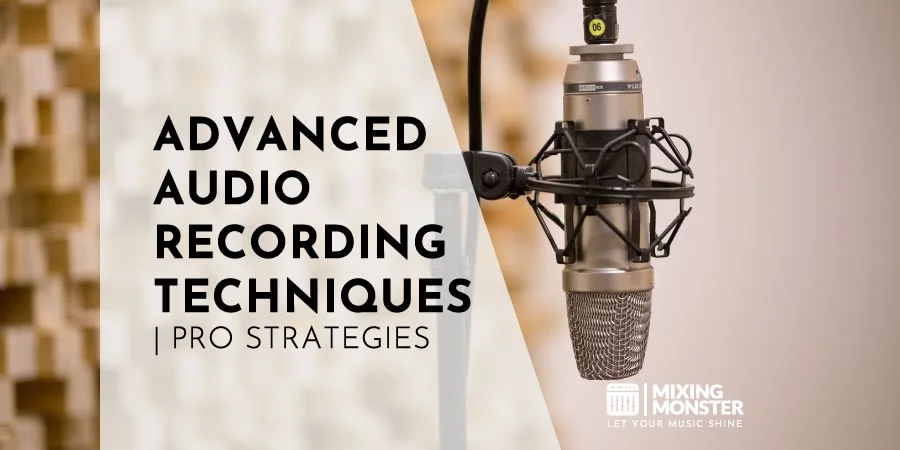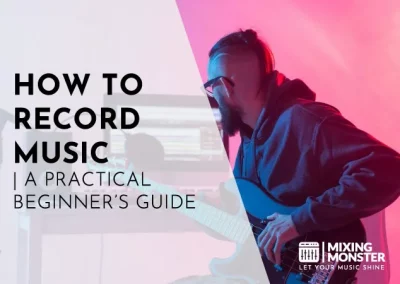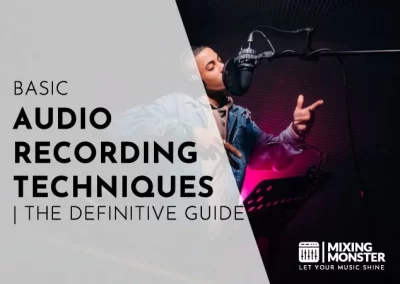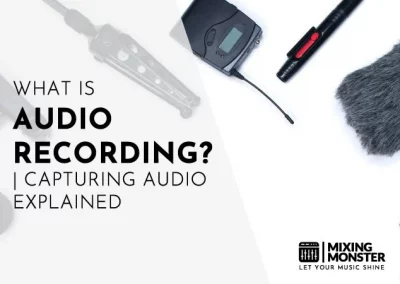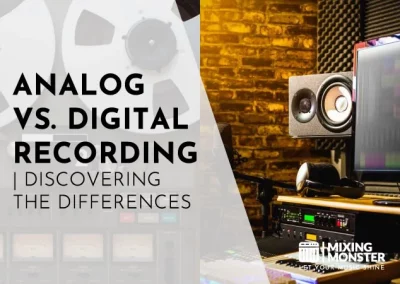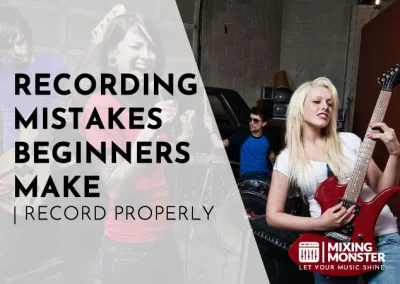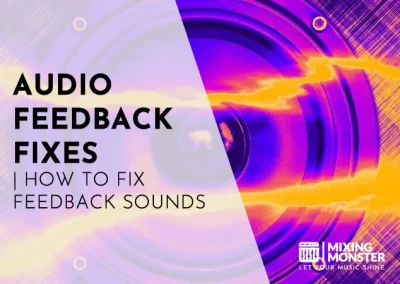Disclosure: Some of the links below are affiliate links, meaning that at no additional cost to you, we will receive a commission if you click through and make a purchase. Read our full affiliate disclosure here.
Advanced audio recording techniques are essential to capture high-quality sound that conveys the full range of emotion and clarity in music and spoken word. With technology rapidly advancing, understanding nuanced recording methods can vastly improve the end product.
Advanced audio recording encompasses a sophisticated skill set that allows audio engineers to capture sounds with clarity and definition. This includes expertise in a range of equipment, such as high-quality microphones and knowledge of room acoustics, which play a pivotal role in the quality of the recorded audio. Further dimensions include the artist’s intent, instrument characteristics, and capturing the dynamism of live sessions.
By investing time into learning the intricacies of advanced audio recording, you stand to gain the necessary tools to excel in this craft. From mastering different microphone techniques to understanding how room acoustics affect your recording and recording various instruments and vocals with excellence—each step is crucial. Step into professional audio recording, enhance your skillset, and create audio works that resonate with your intended audience.
KEY TAKEAWAYS:
- Advanced audio recording significantly enhances sound quality.
- A range of skills and equipment is necessary for optimal recordings.
- Learning these techniques can take your recordings to a professional level.
Table Of Contents
1. Understanding Advanced Audio Recording
2. Microphone Mastery For Advanced Recording
3. Room Acoustics And Optimization
4. The Artist’s Perspective In Recording
5. Recording Different Instruments Like A Pro
6. Vocal Recording Excellence
7. The Art Of Drum Recording
8. Live Session Recording Dynamics
9. Advanced Recording Tips And Tricks
10. Recording Audio Like A Pro
11. FAQ

1. Understanding Advanced Audio Recording
In audio production, advanced audio recording encompasses many techniques and concepts that elevate your sound beyond the basics. It’s essential to grasp these elements to enhance your recordings.
Defining Advanced Audio Recording In The Modern Context
Advanced audio recording refers to the process and technology used to capture audio in high fidelity using complex techniques, often resulting in superior sound quality. At the core of advanced recording is digital audio, which allows for precise sound manipulation.
Advanced recording frequently employs uncompressed WAV formats due to their high quality, though some professionals might opt for MP3 for its smaller file size and portability despite compression.
- Sample Rate:
The number of samples of audio carried per second, measured in Hz or kHz. A higher sample rate means more detailed audio capture. - Bit Rate:
Typically measured in kbps (kilobits per second), the amount of data processed per unit of time directly affects sound quality. - PCM (Pulse Code Modulation):
This method is used to digitally represent analog signals, which, in the context of audio, means a higher fidelity to the original sound.
The Shift From Basic To Advanced Techniques: What Sets Them Apart?
A significant focus on the technical aspects of recording marks the transition from basic to advanced techniques. With advanced techniques, your understanding must extend to the intricacies of audio formats, the implications of different sample rates, and the fidelity outcomes of various bit rates.
- Audio Formats:
Advanced users choose formats wisely based on project needs. - Sample Rate & Bit Rate:
You’ll trade-off between file size and audio quality.
Understanding the balance between these technicalities is crucial for producing professional-level audio. Now, let go of the introductory methods and dive into the sophisticated world of advanced audio recording.
2. Microphone Mastery For Advanced Recording
In this section, you’ll explore the intricacies of microphone types, placement, phase considerations, and the proximity effect to ensure high-quality audio recordings.
Types Of Microphones And Their Advanced Applications
Different microphones serve specific purposes in advanced audio recording sessions. Here’s an overview:
|
Microphone Type |
Best Use Cases |
|
Dynamic |
Live performances, loud sources |
|
Condenser |
Studio vocals, acoustic instruments |
|
Ribbon |
Vintage sounds, electric guitars |
|
Shotgun |
Film audio, focused recording |
|
Lavalier |
Interviews, dialogue |
Dynamic microphones are durable and handle high volume levels well, making them suitable for both stage and studio. Condenser microphones capture more detail and a wider frequency range, leading to a more precise and more accurate representation of the sound, ideal for vocals and acoustic instruments. Ribbons are known for their warm and natural sound, preferred in more nuanced audio settings.
Microphone Placement Techniques For Optimal Sound Capture
Strategic microphone placement is imperative for capturing optimal sound quality. When recording in stereo, consider an X-Y configuration to preserve the sense of space and directionality. Place the microphone at a slight angle off-axis from the mouth for vocals to reduce plosives. Experiment with close miking for detail and room miking to capture ambient sound reflections for instruments.
Phase Considerations In Multi-Microphone Setups
In setups with multiple microphones, phase alignment is critical. When two microphones are capturing the same source, differences in distance can cause phase cancellation, resulting in a thin or hollow sound. To avoid this, use the 3:1 rule as a guide: position secondary microphones at least three times the distance from the sound source as the primary microphone.
Proximity Effect: Utilizing Or Mitigating Its Impact
The proximity effect can be both a tool and a challenge in audio recording. Moving a directional microphone closer to the sound source makes the bass frequencies more pronounced. Use this to your advantage by adding warmth to a thin vocal or mitigate it by placing the microphone further away, ensuring a balanced, true-to-source capture.
3. Room Acoustics And Optimization
When setting up a space for advanced audio recording, acoustics can’t be an afterthought. Your recording quality hinges on how well the room handles sound. Let’s explore how to transform your space to capture pristine audio.
The Role Of Room Acoustics In Advanced Audio Recording
The acoustics of a room significantly affect the fidelity and clarity of your recordings. Uneven or excessive reverberation can lead to a muddy sound, whereas a well-balanced space facilitates accurate sound reproduction. Consider room shape and surface materials, which collectively influence sound reflections, the absorption of frequencies, and, ultimately, the studio sound.
DIY Techniques For Room Treatment And Soundproofing
- Absorption:
Soft materials such as thick curtains or specially designed foam panels can absorb high-frequency sounds, reducing unwanted echoes. - Diffusion:
DIY diffusers can scatter sound waves, creating a more even sound field. Think of uneven bookshelves with a mix of hard and soft materials. - Bass Traps:
Corner-mounted bass traps can help control low-frequency noise accumulating in corners.
These noise reduction strategies can significantly improve the audio capture in your space without stretching your budget.
Professional Equipment And Solutions For Acoustic Optimization
Professional solutions typically offer the best results for refinement in your audio recording environment. Products like calibrated microphones for room analysis and automated digital signal processors tailor the acoustic treatment to your needs. These solutions optimize room characteristics and help create an ideal recording environment.
Visiting forums such as AVS Forum can provide you with advanced insights into room EQ, acoustics, and optimization. If you’re looking for quick practical advice, MusicTech’s tips on acoustics might be helpful, while a more scientific approach can be found in the Audio Science Review.
4. The Artist's Perspective In Recording
The artist’s role in the recording process is psychological and technical, requiring thorough preparation and an environment that fosters the best performance.
Preparing The Artist For The Recording Session
Before you enter the studio, preparation is key to ensure a smooth and efficient recording session. Here’s a checklist to help you get ready:
- Familiarize Yourself With The Material:
Know your parts inside out to reduce time spent on corrections. - Rest Well:
A rested voice and mind contribute to a better performance. - Warm-Up:
Whether it’s vocal exercises or instrument practice, warming up is vital. - Discuss The Vision:
Ensure you and the producer/engineer share the same vision for the recording. - Bring Comfort Items:
Personal items can help create a comforting studio environment.
Techniques To Capture The Best Performance
The nuances of your performance can be significantly affected by recording techniques:
- Soundcheck Thoroughly:
Adjust the mic placement and settings to capture your sound best. - Multiple Takes:
Be bold and record several versions. This allows for more creative choices later. - Experiment With Acoustics:
The room’s acoustics can add a unique character to your recording.
Psychological Aspects Of Recording And Artist Comfort
Your mental state can influence the outcome of a recording session immensely:
- Maintain A Positive Mindset:
Confidence in your abilities will appear in your recording. - Take Breaks As Needed:
Fatigue can hinder your performance, so recognize when rest is necessary. - Constructive Feedback:
Work with professionals who provide helpful and encouraging feedback to enhance your recording experience.
Creating a high-quality recording is not just about the technical aspects; it’s also about ensuring you, as the artist, are mentally and physically prepared to deliver your best performance in a comfortable and supportive setting.

5. Recording Different Instruments Like A Pro
In this section, you’ll learn how to apply advanced techniques to record various instruments with professional quality. We’ll cover critical practices for capturing their unique sounds, from the resonant strings to the dynamic range of electronic instruments.
Advanced Techniques For Recording String Instruments
Microphone placement is crucial when recording string instruments to capture the full tonal quality. Use a small diaphragm condenser for its detailed sound profile and place it close to the f-hole for violins and cellos. Experiment with distance and angles to find the perfect blend of body and brightness. Try a ribbon mic farther from the instrument to pick up room reflections for more resonance.
Recording Tips:
- Distance:
6-12 inches from f-hole - Mic Type:
Small-diaphragm condenser, ribbon for ambiance - Position:
Slightly above and pointed towards the bridge
Capturing The Essence Of Percussion Instruments
With percussion, you aim to preserve the instrument’s natural attack and decay. Start with a dynamic microphone for loud sources like snare drums or a large-diaphragm condenser for a broader sound profile on quieter instruments like bongos. Close miking each drum will give you more control in post-production, while overhead mics capture the kit’s overall sound.
Mic Placements:
- Kick Drum:
Inside the drum toward the beater - Snare:
1-3 inches above the rim, angled down - Overheads:
Equidistant from the center of the snare
Recording Wind And Brass Instruments With Precision
The aim is to get a balanced tone without overwhelming breath noises or key clicks. A condenser microphone is generally preferred for its sensitivity and flat frequency response. Point the microphone towards the bell for brass and the keys for woodwinds; positioning it off-axis can reduce harshness. Consider the room’s acoustics and apply EQ judiciously to avoid muddying the instrument’s natural sound.
Optimal Setup:
- Saxophone:
6 inches off-axis from the bell - Trumpet:
A dynamic mic can handle higher SPLs
Best Practices For Recording Electronic Instruments
Electronic instruments can range widely in frequency and dynamics. A direct input (DI) box is your friend here, ensuring you capture the purest sound straight from the source without interference. For synthesizers and drum machines, recording the direct signal and the ambient room sound can add depth to the mix.
Capture Techniques:
- Synthesizer:
DI for clean signal, condenser mic for room sound - Drum Machines:
Separate tracks for each drum sound for granular control
Remember that recording is both an art and a science. The techniques discussed here provide a starting framework but trust your ears and adjust to suit the specific needs of your music production project.
6. Vocal Recording Excellence
Technical proficiency and creative approaches are essential in pursuing exceptional vocal recordings. This section presents specific methodologies to elevate your vocal recording skills, whether you are capturing solo performances or group harmonies.
Advanced Strategies For Recording Solo Vocals
Selecting a high-quality, large-diaphragm condenser microphone for solo vocal recording can be crucial for capturing dynamic nuances and wide frequency response. An essential technique is to find the ideal distance from the mic, usually between 2 and 12 inches, factoring in the type of microphone and the acoustics of your recording space.
Proper use of pop filters can eradicate or significantly reduce unwanted plosives. Another vital aspect is handling sibilance, which can often be mitigated with judicious mic placement and angle adjustment, avoiding direct sound wave contact with the mic diaphragm.
- Mic Selection:
Use a high-quality condenser microphone - Mic Placement:
2 to 12 inches from the vocalist - Pop Filters:
Place correctly to manage plosives
Techniques For Capturing Group Vocals And Harmonies
Group vocal and harmony recordings require attention to blending and balance. Use multiple microphones and carefully arrange them to pick up the ensemble’s collective sound, ensuring no single voice dominates unless artistically intended. Understanding how to balance the characteristics of each microphone with the room’s acoustics helps achieve a mix that resonates well with the desired sonic landscape.
- Multiple Microphones:
Arrange to capture the ensemble effectively - Balanced Recording:
Adjust levels to blend the group’s sound
Mic Techniques To Address Sibilance And Plosives
Sibilance and plosives are common challenges in vocal recording. To tackle sibilance, angle the microphone slightly off-axis from the vocalist’s mouth, which can diminish the harshness of “s” sounds.
For plosives, besides using pop filters, instructing the vocalist to perform with the correct mic technique or adjusting the input level to avoid distortion helps maintain sound quality. A low-cut filter can also be effective in reducing the impact of plosives.
- Sibilance:
Angle the microphone off-axis - Plosives:
Use pop filters and low-cut filters
7. The Art Of Drum Recording
In drum recording, the balance between technology and technique is essential. Your objective is to capture the true essence of the drum’s sound, from the percussive strikes to the room’s resonance.
Advanced Strategies For Recording Drums
When recording drums, the choice and placement of microphones are crucial. Use a combination of dynamic and condenser mics to take advantage of their respective strengths.
Dynamic mics, rugged with a straightforward pickup pattern, are excellent for close-miking each drum. Condenser mics can handle subtler sounds and are well-suited for overhead and room mics to capture cymbals and ambiance.
An important aspect of advanced drum recording is understanding phase coherence – ensuring that the mics work cohesively to prevent phase cancellation.
- Dynamic Mics:
Suited for snare, toms, and kick drum - Condenser Mics:
Ideal for overheads and capturing room sound
Techniques For Capturing Drum Room Sound
Capturing the drum’s room sound adds depth and a sense of space to your recording. This can be achieved by strategically placing room microphones at varying distances to blend direct and reflected sounds.
Experiment with different mic patterns and positions to best represent the room’s acoustic characteristics. Ribbon mics or large-diaphragm condensers often produce a warmer, more natural room sound.
- Ribbon Mics:
Warm, natural room sound - Large-Diaphragm Condensers:
Broad pickup pattern for spacious sound
Mic Techniques To Record Kick Drums
The kick drum requires attention to detail in microphone placement to ensure you achieve a powerful, punchy sound. A common technique is to use a large-diaphragm dynamic microphone placed inside or close to the sound hole for more attack and low-end presence. For added depth and resonance, consider placing a second mic inside the drum, such as a boundary microphone.
- Inside Placement:
Dynamic mic for attack and presence - Boundary Mic Inside Drum:
Added depth and resonance
You create a full, rich drum sound that stands strong in any mix by integrating these specific strategies, microphones, and techniques.
8. Live Session Recording Dynamics
Mastering live session recording dynamics requires a well-thought-out approach to capture the essence of the performance. This includes:
- Properly set up the recording environment.
- Ensuring a harmonious blend of ambient and direct sounds.
- Utilizing specific mixing techniques to preserve the live experience.
Setting Up For A Successful Live Recording
When preparing for a live recording, your initial focus should be the setup. Versatile microphones and stands are crucial for sound capture across different instruments and room acoustics. Position your microphones to capture the natural ambiance and individual instruments effectively.
Use acoustic treatment to manage reflections and avoid unwanted reverb that could muddy the recording. Verify your gear is in working order and run a soundcheck well in advance to fine-tune microphone placement and levels.
Balancing The Live Room Sound With Direct Feeds
Achieving an optimal balance between the live room sound and the direct feeds from instruments is paramount. It’s beneficial to record using a combination of:
- Ambient microphones to capture the room’s acoustic characteristics
- Close miking techniques for instrument clarity
- Direct Injection (DI) boxes for noise-free electronic instrument feeds
Blend these elements carefully to retain the energy of the live performance while maintaining clarity and separation in the mix.
Mixing Techniques Specific To Live Recording Sessions
When mixing a live session, your techniques will differ from studio production. Consider the following:
- Apply EQ sparingly, prioritizing corrective adjustments over creative ones to maintain the natural sound.
- Use compression with caution to control dynamics without squashing the life out of the performance.
- Create a dynamic mix that reflects the energy fluctuations of the live performance rather than a perfectly polished studio track.
Remember to preserve the authenticity of the live recording, as it’s the raw and genuine character that makes live sessions unique and compelling.
9. Advanced Recording Tips And Tricks
In this section, you’ll learn about the sophisticated techniques that can elevate your audio recordings, leveraging specialized equipment, innovative effect applications, and unique recording spaces.
Utilizing Outboard Gear For Enhanced Sound Quality
Outboard gear includes equipment external to your audio interface or mixer, offering finer control over your sound before it hits the digital domain.
- Preamps:
Use high-quality preamps to add warmth and clarity to your recordings. - Compressors:
Apply hardware compressors to manage dynamics gently and add character. - Equalizers:
Shape your sound precisely using dedicated EQ units for better tonal balance.
Incorporating these devices can significantly enhance your audio’s fidelity, giving you a polished, professional result.
Creative Use Of Effects And Processing In The Recording Stage
Recording with effects and processing can imbue your tracks with a distinctive sonic signature that’s challenging to replicate in post-production.
- Reverb/Delay:
Capture ambient spaces vividly by recording through a hardware reverb or delay unit. - Harmonic Enhancement:
Introduce subtle harmonic distortions with tube processors or saturation units for a richer sound.
Remember, the key is subtlety; it’s about enhancing the recording, not overshadowing the natural qualities of the source.
Recording In Non-Traditional Environments For Unique Sounds
Sometimes, the most unique sound comes from beyond the studio walls. Explore non-traditional environments to capture irreplaceable audio characteristics.
- Outdoor Settings:
Record in forests or urban spaces to infuse your tracks with natural reverb or the ambiance of life. - Adapted Spaces:
Use unconventional locations like stairwells or warehouses for their distinctive acoustic properties.
You can discover unexpected and inspiring sounds for your audio projects by thinking outside the conventional recording space.
Here are several advanced recording tips and tricks to refine your audio capture process:
- Experiment with mic placements aggressively to explore different sound textures.
- Use high-end converters to ensure the purest translation of your sound from analog to digital.
- Implement the M-S (Mid-Side) technique to create a natural and adjustable stereo image.
- Explore binaural recording for immersive 3D audio experiences.
- Consider tape emulation to imbue digital recordings with analog warmth.
- Capture the performance with multiple takes to have a variety of sound dynamics.
- Harness phase relationship knowledge to prevent cancellations and enhance recordings.
10. Recording Audio Like A Pro
Recording audio on a professional level requires precision and an understanding of advanced techniques. In this section, you’ll gain insights into refining your audio recording skills with advanced methods and developing unique approaches to capturing sound.
Recap Of Advanced Audio Recording Techniques
Before creating your signature sound, ensure you’re adept with digital audio workstations (DAWs), such as Pro Tools or Logic Pro. These platforms are the backbone for high-quality audio production. Here’s what you should already be familiar with:
- Audio Editors:
Efficient use of audio editing software is crucial for precision edits and clean transitions. - Audio Codecs:
Knowledge of various audio codecs ensures you can maintain the quality during the encoding and decoding processes. - Encoding And Decoding:
Understand how to maintain audio integrity when converting between formats to prevent quality loss.
Developing Unique Advanced Recording Techniques
Now, let’s focus on developing your techniques. Experiment with your DAW’s features and plugins to craft a sound that’s yours. Consider the following steps:
- Play With Effects:
Try out different effects to discover unique sounds. Reverb, delay, and modulation can transform your recordings. - Layer Tracks:
Combine different audio tracks to create rich textures. - Manipulate Audio Clips:
Use pitch correction, time-stretching, and other advanced editing features to sculpt your sound. - Finesse Transitions:
Smooth-out transitions between clips for a polished result.
By mastering these skills and tools, you’re well on your way to producing professional audio that stands out in the industry. Remember to keep exploring and refining your techniques to stay ahead!
Happy recording!
11. FAQ
1) What software is recommended for professional-level audio recording?
For professional-level audio recording, industry-standard choices include Pro Tools and Ableton Live. Both provide comprehensive tools for recording, editing, mixing, and mastering audio.
2) Are there any quality options for free advanced audio recording tools?
Audacity is a popular free option well-suited for advanced recording and editing tasks. Though more feature-rich than some paid software, it meets many professional needs without the expense.
3) How can one access or download advanced audio recording applications?
Most advanced recording applications can be purchased or subscribed to through their official websites. Some, such as Pro Tools, offer download links directly after purchase or provide access through cloud-based services.
4) What are the best audio recording apps available for mobile devices?
Recording on mobile devices has improved significantly, and apps like Zoom H5 and GarageBand for iOS devices provide considerable quality and flexibility for recording.
5) Can you suggest professional recording microphones with an excellent price-performance ratio?
The Shure SM7B and the Audio-Technica AT2020 are highly regarded microphones for their quality and cost efficiency. They are suitable for both vocal and instrumental recording.
6) What should be considered for achieving high-quality audio recordings?
Factors to consider include:
- The recording environment
- Choice of microphone
- Audio interface quality
- Recording software
- Proper leveling and EQ settings
A well-designed home studio can enhance the quality of recordings significantly.

